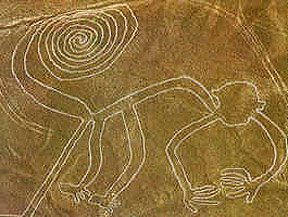
The Nazca Indians lived in
The Nazca Lines are a form of art called geoglyphs, which scientists tell us means "giant pictures drawn on the ground." From the ground, the Nazca lines basically look footpaths. The lines were made by scraping away the dark surface dirt to reveal the lighter colored dirt underneath.
 For centuries, the lines were seen simply as sacred paths used by the surviving remnants of the Nazca and other Indians in the region. In 1927, a local archaeologist named Mejia Xespe "discovered" the lines for modern audiences. When viewed from the air, he found that the apparent paths didn't really lead anywhere and speculated that they were used for pointless "walking around in circles" ceremonies by the Nazca.
For centuries, the lines were seen simply as sacred paths used by the surviving remnants of the Nazca and other Indians in the region. In 1927, a local archaeologist named Mejia Xespe "discovered" the lines for modern audiences. When viewed from the air, he found that the apparent paths didn't really lead anywhere and speculated that they were used for pointless "walking around in circles" ceremonies by the Nazca.
A dozen years later, an American historian named Paul Kosok tried to map out one of the Nazca Line sets and discovered that it kind of looked like a bird. He speculated that the lines functioned as a positional calendar, similar to
To the astonishment of the scientific community, aerial photography documented that the lines were massive pictures drawn across more than 200 square miles. In all, more than 110 pictures and simple geometric structures have been mapped in the region. About 70 of the Nazca diagrams depicted people or animals, including hummingbirds, pelicans and dogs.
There were several reasons why this discovery was astonishing. For one thing, the first millennium C.E. was notoriously short on airplanes, which meant that (in theory) the Nazca could not possibly have viewed the pictures themselves. For another thing, the lines were just scratched into the ground, yet they had endured for several centuries. For another thing, the whole idea was freaky-weird and seemed to demand a freaky-weird explanation.
Worried about the freaky-weird cheering section, scientists rushed to present a rational explanation, which we must admit is sounds as though it may also be the correct explanation. With virtually no historical record to work from, they argued the designs were almost certainly religious in their purpose, for the simple reason that no one would go to so much trouble except for religion.
While the Nazca themselves couldn't see the pictures, their gods would theoretically have a nice vantage point to enjoy the artwork. In principle, there was no reason that a careful planner couldn't chart out instructions for drawing the actual lines. And the lack of water and wind erosion in the Peruvian desert accounted for the lines' longevity.
With all these reasonable arguments nicely articulated, the scientists sat back, clinked their brandy snifters together and fired up some celebratory cigars.
Starting in the 1950s, what ‘rational scientists’ had fear occurred, the lunatic fringe seized hold of the Nazca lines, and they never let go.
UFO enthusiasts began to promulgate a theory that the Nazca Lines were landing strips in a giant runway for aliens who visited the idiot Nazca tribe and helped them build the Nazca Lines, which were so clearly beyond the ability of simple natives to construct. The theory continued to gain popular momentum when it was discussed by Erich von Daniken in his 1968 epic Chariots of the Gods.
Let’s look at a few things. First off, the fallacies behind the "alien landing strip" theory are so extensive that it is impossible to enumerate all of them. However, there are a few which stand out from the crowd:
2. If you put all this aside, and grant for the sake of argument that aliens need landing strips, why would the landing strips look like monkeys, spiders and hummingbirds? Landing strips as we know them are straight -- for rather obvious and practical reasons.
3. If the Nazcas needed alien help to build the landing strips, but the aliens need the landing strips in order to land, how could the aliens have landed in the first place in order to teach the Nazca how to build the landing strips?
Assuming, for the moment, the Nazca hadn't invented a simple hot air balloon, there remains an intriguing mystery. Exactly why would the Nazca draw massive pictures that they could never view themselves?
While the answer is still unknown, there are many rows to hoe before resorting to extraterrestrial intervention -- anything from mental imbalance to religious fervor to illustrating an existential point about the meaninglessness of human endeavor.
Or there could simply be no point to the lines at all. If you have to invoke UFOs every time you need to explain seemingly irrational human behavior, you'll end up blaming aliens for everything from Crystal Pepsi to Al Gore to Wife Swap. You'd think aliens would have better things to do. Besides, let’s give some credit to human beings for a change, isn’t it possible that humans decided for whatever reason to do this and then found a way to achieve it? What ever you view of the Nasca Lines, it sure is more proof that we do indeed live in a big weird world!
I’m Average Joe


No comments:
Post a Comment